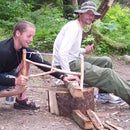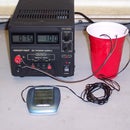Introduction: Measure the Drag Coefficient of Your Car
The purpose of this experiment is to determine your vehicle's drag coefficient Cd and coefficient of rolling resistance Crr. This is done by measuring your vehicle's speed as a function of time while coasting in neutral.
Why would you want to know Cd and Crr for your vehicle? Well, suppose you're interested in modifying your vehicle for improved fuel efficiency. You might consider modifications such as air dams, wheel skirts, removing mirrors, switching to low rolling resistance tires, etc. Cd and Crr offer a quantitative method of comparing vehicle performance before and after these types of modifications to see if you made any improvement.
For other experiments you can do on your car see my website IWillTry.org.
Step 1: Equipment
- a vehicle (and someone with a driver's license)
- a clock or stopwatch
- a pen and paper (and someone other than the driver to record data)
- a flashlight (driving at night avoids traffic)
- a long stretch of flat road with little traffic or wind
- Excel or another spreadsheet application. I prefer OpenOffice Calc because I like to support open source software, but its Solver function does not handle non-linear systems (yet) so you'll have adjust input variables manually by an iterative process to fit your model to the data (it's not too hard).
- The spreadsheet I created to analyze the results. Download here: Drag_Coefficient.xls
Step 2: Background Information
First, let's define some quantities:
Fd is the force on the vehicle due to air resistance (drag) in Newtons
Frr is the force on the vehicle due to rolling resistance in Newtons
F is the total force on the vehicle in Newtons
V is the vehicle's velocity in m/s
a is the vehicle's acceleration in m/s^2
A is vehicle frontal area in m^2
M is vehicle mass including occupants in kg
rho is the density of air which is 1.22 kg/m^3 at sea level
g is the gravitational acceleration constant which is 9.81 m/s^2
Cd is the vehicle's drag coefficient we want to determine
Crr is the vehicle's coefficient of rolling resistance we want to determine
Now for some formulas:
Fd = -Cd*A*0.5*rho*V^2 (formula for force due to air resistance or drag)
Frr = -Crr*M*g (formula for force due to rolling resistance)
F = Fd + Frr (total force is the sum of Fd and Frr)
F = M*a (Newton's second law)
Note that both Fd and Frr are negative indicating that these forces act opposite to the direction of the velocity. Note also that Fd is increases as the square of velocity. This is why driving at high speeds is much less efficient than driving at low speeds. Combining these formulas with a bit of algebra gives us the acceleration due to air and wind resistance as a function of velocity:
a = -(Cd*A*0.5*rho*V^2)/M - Crr*g
Note that the acceleration is negative indicating that air and wind resistance will cause the velocity to decrease.
I created a spreadsheet based on these formulas to generate a model of velocity vs time that can be compared to actual data. The model values for Cd and Crr can thus be adjusted until the model matches the data. This adjustment can be done manually, by overwriting the values of Cd and Crr with new values till the model matches the data, or it can be done using a "Solver" function.
Step 3: Procedure
You can determine Cd and Crr from the same set of test data by measuring velocity with respect to time as your vehicle coasts in neutral. Note that Crr will not be pure rolling resistance but will include some drive-train resistance as well.
1. Drive to a flat road with little traffic or wind.
2. Have the passenger ready with stopwatch and paper to record data.
3. Have the driver accelerate up to above 70 km/h or so, and shift into neutral.
4. Record data as follows. The driver should indicate when the speed drops to exactly 70 km/h. At this time (t=0) the passenger should start the clock. The passenger should indicate every 10 seconds after that and the driver should call out the current speed to the nearest whole km. The passenger should record this value next to each time.
Aside: If you have a digital camera capable of recording several minutes of low resolution video (as most people seem to have these days), the process is much easier and more accurate. You don't need any equipment except the digital camera. Simply have your passenger record a video of your speedometer during the coast down tests, or find some way of mounting the camera so you can do the recording without an assistant. Using a free program such as Avidemux (http://fixounet.free.fr/avidemux/) you can play the video back on your computer frame by frame and view the timestamp at desired speeds.
5. Repeat the test in the opposite direction.
6. Repeat the test in both directions twice more (6 trials in all, 3 in each direction). All these values will be averaged for a more accurate analysis.
7. Download the spreadsheet I created Drag_Coefficient.xls and enter all your data following the instructions included. The spreadsheet averages data from all 6 trials to create a single data set representing velocity (V actual) as a function of time. It then generates it's own model for velocity (V model) based on entered constants and initial guesses for Cd and Crr. Excel's "Solver" function can be used to adjust Cd and Crr in order to minimize the error between the model and actual data. If you are using OpenOffice Calc (which I highly recommend and which you can download for free from http://www.openoffice.org), unfortunately, the solver function currently only handles linear systems, so you will have to adjust the input values manually to minimize the error between the model and the data. Once the error is minimized and the model data matches the actual data as best it can, then Cd and Crr are correct.
Step 4: Results
Here are the quantities I measured for my car (a 1992 Geo Metro):
M = 1000 kg (about 850kg curb weight plus 150 kg of occupants)
A = 2.3 m^2 (a good approximation based on measurements of my car)
A plot of velocity vs time is shown below. It is based on the averages from my 6 trials. You can see that the model curve closely matches the data points. The values of Cd and Crr for the model are:
Cd = 0.370
Crr = 0.0106
Therefore, these are the drag coefficent and coefficient of rolling resistance for my car.
These values are nice to know. However, in practice, if you want to compare performance before and after making modifications to your car, you can get faster results just by measuring the time to decelerate from speed A to speed B. Pick high to medium speeds if your modifications are likely to affect drag. Pick medium to low speeds if your modifications are likely to affect rolling resistance. Don't forget to take multiple measurements in each direction and average the results.
For more experiments you can do on your car see my website IWillTry.org.
Update 2009-01-02:
I've learned a lot since originally posting this instructable 16 months ago. I've played with measuring Cd and Crr under different conditions on a number of vehicles and other experimenters have picked apart and tweaked my spreadsheet for their own uses.
My experience is that there IS a mistake in one of the underlying assumptions of the model: namely that the force of rolling resistance is constant independent of V. Vehicles are designed with negative lift (so they get pushed into the road more at higher speeds, improving handling) so the force of rolling resistance also has a component that varies with V2 like the drag force. The force of rolling resistance also includes a small component of viscous force (drivetrain) which varies with V.
The model assumes that the drag force is related only to V2 and that the force of rolling and drivetrain resistance is constant. In reality the force of rolling and drivetrain resistance is also related to V2 and V. So a better model of the force on a moving vehicle is:
F = iV2 + jV + k where i, j, and k are constants.
A curve based on that model more closely matches actual coast down data indicating it is a more accurate model. But after solving for i, j and k, there is no way to extract meaningful values of Cd and Crr since by definition, they assume i is related only to drag, and j is 0, neither of which is entirely true.
As mentioned above, If you want to compare performance of a vehicle before and after making mods, the change in coast down time itself is MUCH more meaningful than any change in Cd or Crr extracted from the coast down data.













